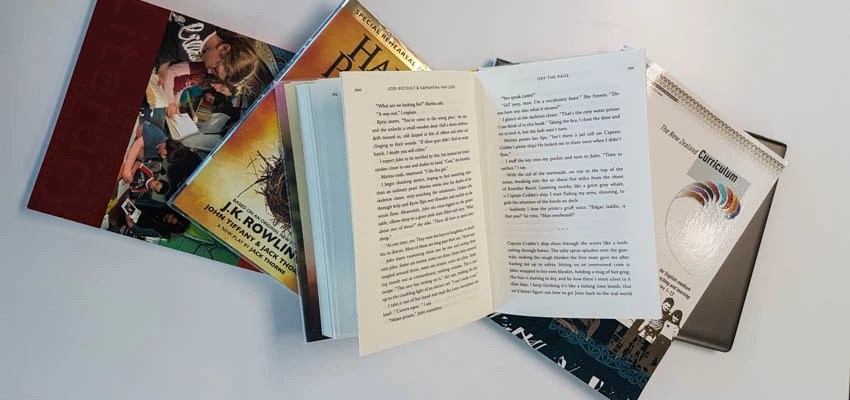Helping students choose books to read for pleasure

Library staff and teachers create engaged readers by helping students understand their reading interests and how to find a ‘just right’ book. Find tips to help students know what they like to read, and how to browse and select books to read for pleasure.
The role of enabling adults in readers’ lives
Knowing who you are as a reader and how to choose what to read may seem like second nature. But, as with many things, this didn't happen by chance. Somewhere along the way, someone helped guide you.
… start to do our thing — pulling books, finding, hunting, searching for any type of print that matches a given student's targeted interest … then we pull him or her aside and deliver the message in both word and deed: I thought of you …
— Steven Layne, Igniting a Passion for Reading
As an enabling adult, you can:
reflect on your reading practices and model how to be a reader
use evidence-based practice
build relationships and know your students' interests
teach book-selection strategies
immerse students in literature
encourage reading plans
collaborate with library staff.
Teachers Creating Readers Framework and examples of practice
Reflect on your reading practices
When you reflect on how you choose what to read, you identify your reading strategies. These include:
having skills to browse and select books
the wider contexts that support reading choices — such as how you find book recommendations, whether your family are readers and encourage reading
understanding your reading preferences
knowing your purpose for reading — delight, discovery, interest, knowledge.
Sharing reading strategies with students helps them discover and explain what they like to read and why. It develops their sense of self as a reader. It strengthens their browsing and selecting skills and helps lead to a lifetime of reading for pleasure.
Model how to be a reader by sharing:
how you choose what to read
your reading preferences
where you source and share recommendations.
Use evidence-based practice
Evidence-based practice takes a learner-centered approach and includes evidence:
for practice
in practice
of practice.
Finding evidence of measured outcomes is essential to understanding how you can support your students.
When trying out new ways to help students choose what to read, it's helpful to gather information about their skills and attitudes. For example, you can do a quick survey before or after your changes to find out:
how they choose books
their level of confidence and success
strategies they use to choose
any issues they may have.
Evidence-based practice and why it matters
Using the data
Consider how best to use the data collected from students. You could collate their responses in a graph, infographic or summary and share the results with students, staff and whānau.
Discover students’ reading interests
‘Have I got a book for you!’ ‘When I saw this book, I thought of you’ or ‘I think you'd enjoy reading this’.
These are the voices of teachers and school library staff who know the literature, their students and can successfully bring them together.
… the thing is with helping students become readers who like to read, it is not about just finding one book. It is about finding one book they love and then finding the next one, and then the next. That doesn’t simply happen no matter what we tell kids. It takes work, patience, persistence, and even some luck at times. It takes conversations and questions and hope for every child. It takes relationship and communication. Honesty and even frustration. It takes you knowing a child and a child knowing themselves.
— Pernille Ripp, They don’t just need to find the right book
Find out by surveying your students
A written, oral or online survey can produce some very useful information about your students' reading preferences. You might ask:
what series or authors they enjoy
what genres or forms they prefer
what non-fiction they have enjoyed
what they read online
what stops them from reading
what was the last book they chose to read
approximately how many books they read in a year.
Genres and forms in children's and young adult (YA) fiction
A quick search for reading surveys will give you a starting point. Or use one created by writer, educator, and international literacy expert, Pernille Ripp: Reading forms I use.
Other ways to discover students’ reading interests
Chat to students about what they like and dislike.
Play games or activities that give you an insight into reading preferences, for example, desert island texts or ‘would you rather’?
Set up a suggestion book, box or online form for students to recommend books.
Allocate time for formal and informal book chats as a class or in groups or pairs.
Provide opportunities for them to vote, for example, best book-to-film adaptation, best opening paragraph, battle of the books.
Teach strategies to help students choose books
Depending on how confident a student is about their reading identity, choosing books can either be enjoyable or frustrating.
Teach students different strategies to select books. And give them the time and space to practice.
Students who know what they like to read
For students who know their reading preferences, browsing strategies may include looking for:
favourite authors
authors they've heard of and are interested in reading
titles recommended by family, friends and reviews
favourite genre sections (if books are arranged this way)
recently returned books
new book displays
books that are shortlisted for book awards.
Unleash the power of shadowing book awards
Younger readers
For younger readers, selection strategies may include:
Goldilocks strategy — is this book too easy, too hard or just right?
I PICK mnemonic for ‘good fit’ books — I choose a book:
that meets my Purpose
that matches my Interest
that I can Comprehend
where I Know enough words.
Other general strategies
Look at the title and the cover — does it appeal?
Read the blurb — does it interest you?
Read the first page or two.
Read information about the author on the jacket.
Look at the print size or layout for ease of reading.
Listen to friends’, teachers’, parents’ and library staff’s suggestions.
Look for popular authors and series.
Use online literature maps, ‘what next’ websites, branching out or gateway book lists.
Check displays.
It's also important to remind students to experiment. Share your own stories of trying something new. Some important messages include:
Give a book a fair chance — read several pages or chapters before giving up on it.
Try different genres and forms.
Genres and forms for young adult and young fiction
Immerse students in literature
Helping students choose what to read is also about the wider reading culture context — helping students become literary, not just literate.
For young or struggling readers without rich book knowledge or wide reading experience, choosing what to read is more challenging. It's therefore important to immerse students in literature. This gives them the vocabulary, examples and recommendations they can apply when browsing.
Plan and schedule regular and dedicated time for reading aloud to your students.
Make time for regular book talking and discussion. Talk about:
why you chose the book
who else might like it
what kept you reading to the end or why you gave it up
connections made with self, other texts, the world
enthusiasms, puzzlements and more.
Other ideas might include:
Book clubs and literature circles. Discuss the plot, characters, setting, themes or explore the genre and more.
‘Risk it for a biscuit’ and other strategies to get students to try a new title or genre.
Displays of books read and discussed in class that students can refer to.
One teacher's journey towards building a class reading culture
Encourage reading plans
Reading plans, in whatever form, help students know what to read next.
Some effective ways of keeping reading momentum include these strategies:
Hooking students into a series, particular authors or genres.
Encouraging students to keep an easy reading log or record of books they have tried and enjoyed. Perhaps use Goodreads or LibraryThing.
Making a simple ‘someday’ or ‘books to consider’ list for future reading. Encourage students to jot down titles from peer recommendations, reviews or book talk sessions to refer to when browsing.
Another idea is having reading requirements. The Book Whisperer author, Donalyn Miller, requires her middle-grade students to read 40 books a year. She allows free choice of titles but insists on a range of genres.
The 40-book challenge revisited
Collaborate with library staff
The library is an essential resource. Draw on the expertise of library staff to help scaffold students as they look for their 'just right' books.
It's only in a library that all children of all backgrounds can freely explore the huge range of books and where they have the freedom to find their own tastes and discover literature at their own pace.
— Ursula Dubosarsky, SCIS Connections, May 2014
Library staff know their collections. They can make connections between book and reader, telling them ‘I thought of you’ or ‘I think you'll enjoy this’.
Work alongside the library staff. Strategies they could use include:
Explicitly promote books across ages. Promote easy reading fiction as ‘quick reads’ to older children. Help struggling readers find books that suit their interests and abilities.
Limit choice for students who are overwhelmed. For example, put together a box of ‘books you might enjoy’ with 10 or so titles.
Promote books through visitors or experiences.
Use digital tools to connect readers with books, authors or students from other schools.
Books and Reads — for kids and teens
Find out more
Becoming a classroom of readers — Donalyn Miller, ASCD, 2010.
Personalized expert guidance of students' book choices in primary and secondary education — Reading Psychology, 2022.
‘We talk books’: Teacher librarians promoting book discussion to foster reading engagement — English in Australia, 2020.
Miller, D., & Lesesne, T. (2022). The Joy of Reading. Portsmouth, Heinemann.
Ripp, P. (2017). Passionate Readers: The Art of Reaching and Engaging Every Child. Routledge.
Related content

Independent reading
Giving students time to read a book of their choice during the school day, for pleasure, is one of the most effective ways to build a reading habit.
School staff as readers
All school staff — leaders, teachers, library staff and others — are vital reading role models. To inspire and encourage your students to become engaged readers, you need to read, know the literature and share your passion.